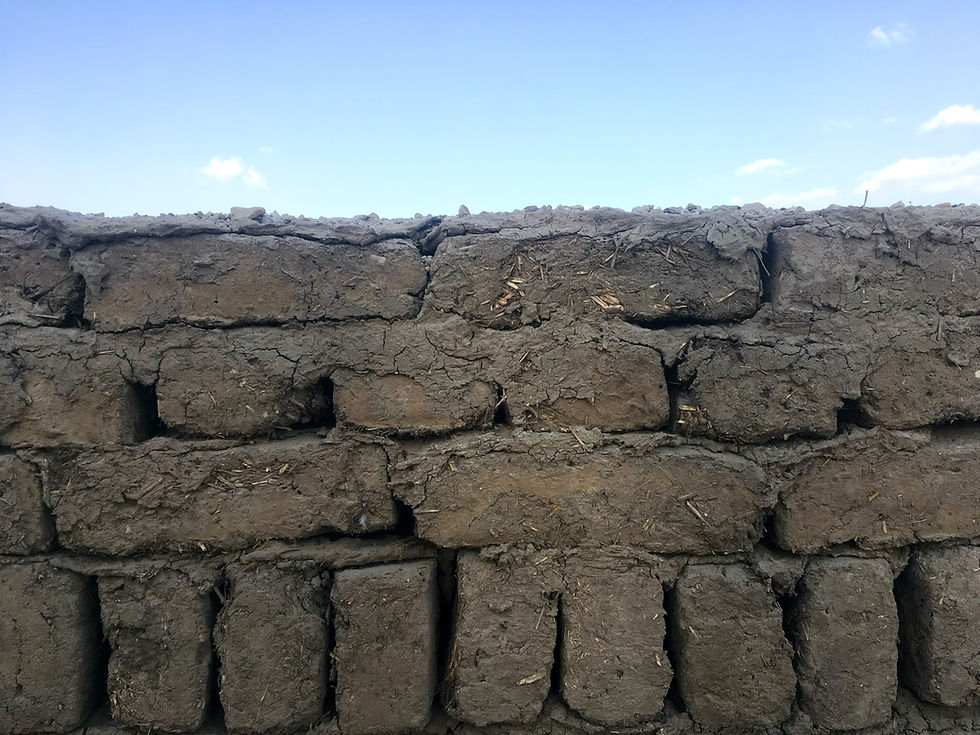Brick by (boring) brick
- Anna Sunneborn Gudnadottir

- Nov 28, 2022
- 3 min read
Throughout history different kinds of building techniques and materials have dominated the fashion and knowledge of their time. One of them is the mudbrick. The development of mudbrick technology likely stems from the earlier plaster-and-daube technique which used mud to plaster flimsy walls made of twigs to make them sturdier.

Depending on where in the world, and for what use, mudbrick can either be sun dried or baked.
Sun-dried mudbricks are a combination of sediments such as clay and sand together with a temper which acts as a binding agent – which is to make sure the brick does not crack when it dries. The sediment contains sand, silt, and clay – basically, natural elements from the surrounding area. The temper may include man-made elements, such as crushed bricks or ceramic grog, or it could include natural minerals and organic materials, such as straw or dung.
Mudbricks can be used to examine ancient technology, production organisation, architectural styles, construction methods and phases, as well as chronological sequences. Sadly, they rarely receive as much attention as other, more “interesting” artefacts.
Egyptian mudbrick
In ancient Egypt, the mudbricks were usually sun dried and were generally made from the alluvial clay of the Nile (in other words, Nile mud) and some temper. When the recipe was mixed to perfection, all that was left to do was to put the mixture into moulds and let the bricks dry in the hot desert sun.

We know that at least two different kinds of bricks existed in Egypt; the black mudbrick and the white. Usually the white bricks seem to have been used for fancier buildings. Not only can these be seen at archaeological sites such as the mudbrick forts from the early Middle Kingdom, references to these can be found in administrative documents such as the Papyrus Reisner.
Middle Eastern Mudbrick
In sites in the Middle East, such as research at Tel Lachish (close to modern Lakhish, Israel) tells us that the quality of mudbrick composition and manufacture differed depending on what function the buildings served, as well as when the building was built. This indicates that what was presumed to be “better quality” was used in higher status buildings.
Other studies in the Middle East, such as studies of mudbrick in the Neolithic site Çatalhöyük (in Turkey), revealed that the greatest degree of difference in composition occurred during the manufacturing process, and not due to what raw material was available. It also showed that the colour of the brick could differ greatly but that it did not necessarily mean a difference in status in the buildings as the analyses that were made showed no pattern in recipes. Some bricks of the same colour could have completely different recipes, and some with different colours could have similar recipes. As such, it is hard to draw conclusions saying that, at Çatalhöyük, the colour of the brick indicated status.

These examples, which span several millennia and a wide geographic region, show that different cultural practices had different priorities when it came to the colour and the recipes of the bricks. Sadly, a lot of mudbrick architecture has been lost not only because of how degradable it is but also because it is a great fertiliser and present day people tend to use crushed mudbrick in agriculture.
Even though millennia have gone by since the first use of bricks, we still use them today. Sun dried mudbricks are still used today in warm climates – and in colder, wetter climates fired bricks are very common.
Text: Anna Sunneborn Gudnadottir. MENAM Archaeology. Copyright 2022.
Images: Mudbricks Anna Sunneborn Gudnadottir.
Mudbrick structure Anna Sunneborn Gudnadottir.
Mudbrick mould The Metropolitan Museum of Art
Further reading:
Serena Love (2017) Field Methods for the Analysis of Mud Brick Architecture, Journal of Field Archaeology, 42:4, 351-363, DOI: 10.1080/00934690.2017.1345222
Morgenstein, Maury E.; Redmount, Carol A. (1998). "Mudbrick Typology, Sources, and Sedimentological Composition: A Case Study from Tell el-Muqdam, Egyptian Delta". Journal of the American Research Center in Egypt. 35: 129–146
Text: Anna Sunneborn Gudnadottir. MENAM Archaeology. Copyright 2022.
Images: Mudbricks Anna Sunneborn Gudnadottir.
Mudbrick structure Anna Sunneborn Gudnadottir.
Mudbrick mould The Metropolitan Museum of Art
Further reading:
Serena Love (2017) Field Methods for the Analysis of Mud Brick Architecture, Journal of Field Archaeology, 42:4, 351-363, DOI: 10.1080/00934690.2017.1345222
Morgenstein, Maury E.; Redmount, Carol A. (1998). "Mudbrick Typology, Sources, and Sedimentological Composition: A Case Study from Tell el-Muqdam, Egyptian Delta". Journal of the American Research Center in Egypt. 35: 129–146



Comments